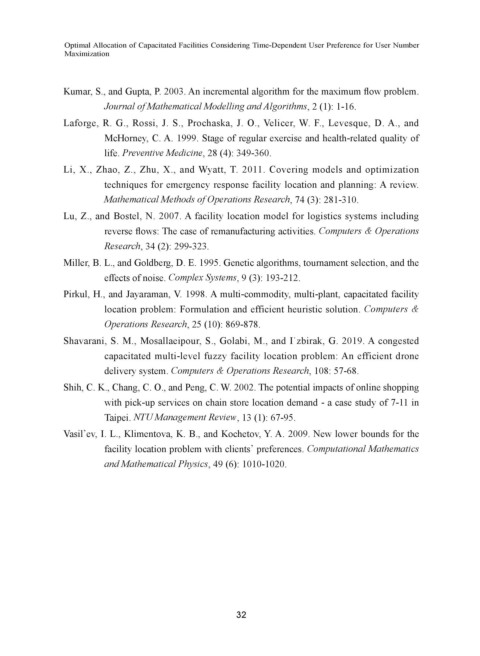Page 40 - 33-3
P. 40
Optimal Allocation of Capacitated Facilities Considering Time-Dependent User Preference for User Number
Maximization
Kumar, S., and Gupta, P. 2003. An incremental algorithm for the maximum flow problem.
Journal of Mathematical Modelling and Algorithms, 2 (1): 1-16.
Laforge, R. G., Rossi, J. S., Prochaska, J. O., Velicer, W. F., Levesque, D. A., and
McHorney, C. A. 1999. Stage of regular exercise and health-related quality of
life. Preventive Medicine, 28 (4): 349-360.
Li, X., Zhao, Z., Zhu, X., and Wyatt, T. 2011. Covering models and optimization
techniques for emergency response facility location and planning: A review.
Mathematical Methods of Operations Research, 74 (3): 281-310.
Lu, Z., and Bostel, N. 2007. A facility location model for logistics systems including
reverse flows: The case of remanufacturing activities. Computers & Operations
Research, 34 (2): 299-323.
Miller, B. L., and Goldberg, D. E. 1995. Genetic algorithms, tournament selection, and the
effects of noise. Complex Systems, 9 (3): 193-212.
Pirkul, H., and Jayaraman, V. 1998. A multi-commodity, multi-plant, capacitated facility
location problem: Formulation and efficient heuristic solution. Computers &
Operations Research, 25 (10): 869-878.
Shavarani, S. M., Mosallaeipour, S., Golabi, M., and I˙zbirak, G. 2019. A congested
capacitated multi-level fuzzy facility location problem: An efficient drone
delivery system. Computers & Operations Research, 108: 57-68.
Shih, C. K., Chang, C. O., and Peng, C. W. 2002. The potential impacts of online shopping
with pick-up services on chain store location demand - a case study of 7-11 in
Taipei. NTU Management Review, 13 (1): 67-95.
Vasil’ev, I. L., Klimentova, K. B., and Kochetov, Y. A. 2009. New lower bounds for the
facility location problem with clients’ preferences. Computational Mathematics
and Mathematical Physics, 49 (6): 1010-1020.
32

